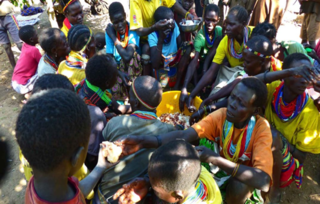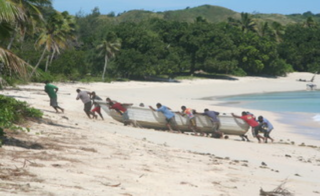Altruism
Why Paying-It-Forward Is Good for You and Your Neighbor
The curious relationship between generosity and unpredictability
Posted August 17, 2019
This article is co-written by one of the researchers in this field, Diego Guevara Beltrán.
Imagine a famine that affects everyone in a community simultaneously. Food is so limited people hardly ever share. Sharing is so rare; even family members are unwilling to share with each other.

Now, imagine you are an anthropologist who happens to study this community only during this time of famine. You may wonder what it is about the culture that makes them this way? As an outsider, you might conclude that people within this community do not value generosity and that their very culture is selfish and unkind.
Such a community exists. The Ik, a group of former foragers in northeastern Uganda, experienced a famine in the 1960s so severe they were inappropriately dubbed “the selfish people” (Turnbull, 1972).
Fortunately, famines don’t last forever. Thanks to the ethnographic fieldwork of Human Generosity Project postdoctoral student Cathryn Townsend, we now know the Ik do, in fact, value generosity, and they help their neighbors when genuinely able. Still, one question remains: How does a community like the Ik, once dubbed the selfish people (or any other group for that matter), grow into a community of generous individuals?

The Human Generosity Project is a large-scale trans-disciplinary effort to better understand the interrelationship between biological and cultural influences on generosity, mutual aid, and other forms of cooperation. Work through this project has shown that dealing with hardships, especially when those hardships happen unpredictably, can turn generosity into the best long-term defense against misfortunes.
We have learned from the Ik that under dire conditions, people simply cannot afford to be generous. When a single event, such as famine, impacts many members within a network, most individuals within that network will be unable to help one on another, even if they would like to.
If, however, only a few individuals within a network are affected, then the other parties have the ability to help—should they choose to. When things are going well for everyone, there is less need for generosity. Generosity appears more prevalent within communities when a few individuals experience hardships, while others are doing well or are unaffected by the same event.
Hardships seem to be an important piece of the generosity puzzle. For better or for worse, hardships are a part of everyday life. When faced with adversity, people can go at it alone, ask for help, or some combination of both.
Maasai herders in East Africa, for example, participate in a cultural system of exchange to manage their hardships. In one type of relationship, people call upon their partners for help when genuinely in need. In turn, partners help if genuinely able, and they do so without expecting anything in return. This mutual dependence is captured by the term Osotua, which literally means “umbilical cord.”
Maasai also participate in Esile, literally meaning “debt,” in which people call upon partners for help. In contrast to Osotua, one is expected to repay Esile in kind, or the relationship can be damaged or terminated.
Why do people sometimes help generously without expecting any kind of repayment, as in Osotua, and at other times help in the form of a transaction, as in Esile? Researchers from The Human Generosity Project observed that the predictability of the timing of hardships is important to explain when people expect repayment for helping versus when people help without expecting something in return.

Human Generosity Project co-directors Lee Cronk, an anthropologist at Rutgers University, and Athena Aktipis, a psychologist at Arizona State University, found exactly this pattern among a group of ranchers on the border of Arizona and New Mexico.
They asked about the kind of hardships ranchers face, the predictability of those hardships, what kinds of help ranchers give each other, and what people expect in return when helping a neighbor. A sizeable minority of ranchers are unwilling to say they or their neighbors expect anything in return for helping one another under any circumstances. However, most say that they do expect something in return when the reason for giving help is something that arises at predictable times.
Branding, for instance, occurs seasonally, so when ranchers help a neighbor to brand cattle, they often expect repayment in kind. Injuries are much less predictable; accordingly, ranchers rarely expect anything in return for helping an injured neighbor. Ranchers refer to helping in both situations as “neighboring.”
The following quotes from interviews with ranchers illustrate the psychology of neighboring:
Regarding routine work, “It’s maybe expected to get the favor returned, but when it’s an emergency, it’s just the neighborly thing to do.”
“I don’t think anybody keeps track. If you kept track, it would become a headache... If somebody needs help, you help them... My family’s never worked that way and we never will... been here since 1918... It all comes out in the wash.”
“It’s a solidarity type world.”

The ranchers’ behavior teaches us that people may be more generous when helping with unexpected needs compared to needs that are thought to be more predictable. Timing of need appears to be an important piece of the generosity puzzle.
There is yet another—and quite obvious—problem with being generous: it can be costly. This is especially true in societies where people have little to no accumulated wealth.
Think, for example, of a hunter who has managed to capture a small animal. If he eats it all himself, he’ll have eaten enough for one day, but if he shares it with someone else, he will still be hungry. Or consider an East African herder, who may also be better off keeping all his cattle for himself and his family rather than sharing some of them with neighbors in need.
Most ranches in New Mexico and Arizona are family-owned, and ranchers work long hours, so they, too, might be better off mending their own fences instead of their neighbors’. Yet, even when resources are limited, generosity can be observed in virtually every human society regardless of size, complexity, or type of economy (Cronk et al., 2019).
To understand why people are generous, even when circumstances may be dire, we need to understand the difference between pure generosity and helping while expecting something in return. Having other people around who are willing to help when misfortune strikes is sometimes the best type of (informal) insurance policy people have in many parts of the world. When there is an expectation of repayment, and one party fails to fulfill the repayment, that cooperative relationship might be damaged or even terminated.
In contrast, there is no failure to repay generosity because nothing is expected in return. People might be better off helping their neighbors without keeping track or expecting anything in return. As one of the ranchers said, "If you kept track it would become a headache.” The consequence of not being generous might be losing a partner who could otherwise help in the event of unforeseen misfortune.
Lastly, whether people help generously as with unpredictable hardships, or whether people expect repayment as with needs that arise with predictable timing, people have to be nested within networks of concurrently interacting individuals. Neither generosity nor debt like transactions can prosper in communities where people are unlikely to see each other in the future. Under such circumstances, we are likely to see communities of individuals who never help one another, or only do so in the form of immediate transactions.

Generosity is good for keeping friends around who are willing to help when the unexpected happens. Fortunately, psychological research also finds that there are positive mood, health, and overall well-being benefits to being generous. A review of 17 studies that included more than 70,000 participants combined found that people who spend their time helping others report greater life satisfaction, higher quality of life, and lower rates of depression.
Impressively, a study employing data from the Gallup World Poll that included participants from over 130 countries replicated the link between volunteering and well-being. The benefits of generosity do not stop with volunteering time. People who spend money on others also report higher levels of well-being. Spending money on gifts or donating to charity, for example, increases overall happiness.
In fact, donating money to charity was one of the top six predictors of life satisfaction in a sample of over one million people around the world (Aknin, Whillans, Norton & Dunn, 2019). This relationship between generosity and well-being can be found among non-Western, small-scale villagers, who report greater happiness after purchasing candy for another than when purchasing it for themselves. In fact, even toddlers express bigger smiles when giving treats to a puppet than when receiving them from an experimenter (Aknin, Hamlin& Dunn, 2012).
According to the 2019 World Happiness Report (Aknin, Whillans, Norton & Dunn, 2019), helpers are more likely to reap the benefits of their generosity when three things are true:
1. They decide how to help.
2. They feel connected to those they are helping.
3. They can see the results of their generosity.
Perhaps the ubiquity of hardships across history and across cultures and societies has taught us that helping others is, in fact, helping ourselves—in a way, paying it forward. As one of the New Mexico/Arizona ranchers stated, “It all comes out in the wash.”
Helping others without keeping track might have been the best defense against hardships people had for a very long time in human history, and it might still be the best available defense against misfortunes people have today in societies where formal social insurance institutions are sparse or do not exist. Even within prosperous societies, generosity may lead to improved health and psychological well-being.
Thanks for following the blog. Comments appreciated.
Diego Guevara Beltrán is a third-year Ph.D. student in social psychology. He works in the Cooperation and Conflict Lab at Arizona State University and is a member of the Human Generosity Project.
References
Aknin, L. B., Hamlin, J. K., & Dunn, E. W. (2012). Giving leads to happiness in young children. PLoS one, 7(6), e39211.
Aknin, L. B., Broesch, T., Hamlin, J. K., & Van de Vondervoort, J. W. (2015). Prosocial behavior leads to happiness in a small-scale rural society. Journal of Experimental Psychology: General, 144(4), 788.
Aknin, L., Whillans, A. V., Norton, M. I. & Dunn, E. W. (2019). Happiness and prosocial behavior: An evaluation of the evidence. In J. Helliwell, R. Layard & J. Sachs Eds. World Happiness Report 2019, New York: Sustainable Development Solutions Network.
Cronk, L., Berbesque, C., Conte, C.,Gervais, M., Iyer, P., McCarthy B., Sonkoi, D., Townsend, C.& Aktipis, A.(2019). Managing risk through cooperation: Need-based transfers and risk pooling among the societies of the Human Generosity Project.In Global Perspectives on Long-Term Community Resource Management, Ludomir R. Lozny and Thomas H. McGovern, eds. Springer.
Jenkinson, C. E., Dickens, A. P., Jones, K., Thompson-Coon, J., Taylor, R. S., Rogers, M., ... & Richards, S. H. (2013). Is volunteering a public health intervention? A systematic review and meta-analysis of the health and survival of volunteers. BMC public health, 13(1), 773.
Turnbull, C. (1972). The mountain people. New York: Simon and Schuster.




